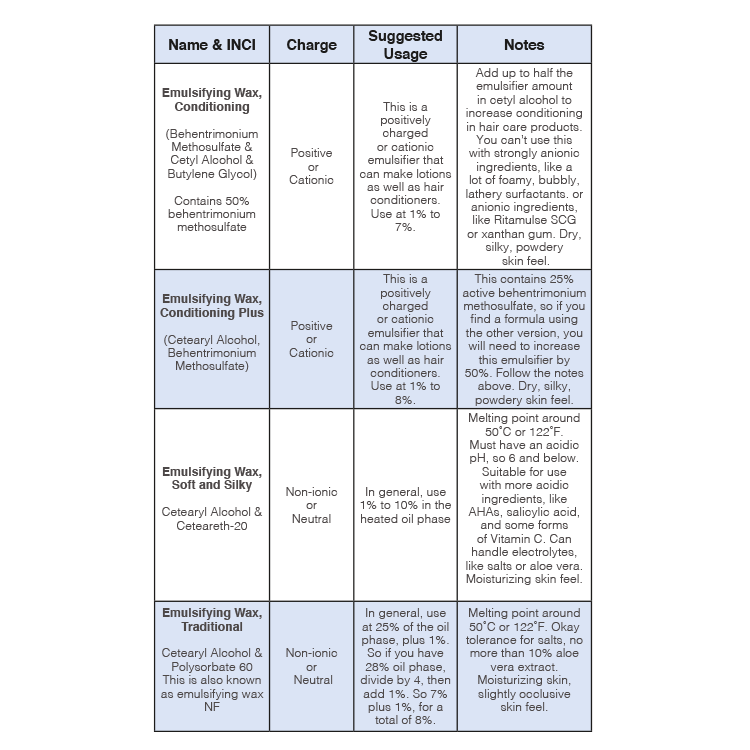What the heck are emulsifiers, and why are they necessary? Oil and water want to hang out together as much as the headbangers and preppies did back in my day, so if we want to make a lotion, we need to create optimal conditions to make it work. This consists of three things – good chemistry, in the form of an emulsifier used at the appropriate usage rates; proper mixing, using either a hand mixer or a stick blender; and lots of energy in the form of heat.
Substances want to hang out and mix with other things like themselves. Water is polar, meaning one end is negatively charged and one end is positively charged, so it mixes easily with other polar things, like alcohol, glycerin, or propylene glycol. Oil is non-polar, meaning it has no charge, so it wants to mix with other non-polar things, like esters, butters and waxes. To bring them together requires a special ingredient that can be a little bit of both, and we find that in our emulsifiers.
Emulsifiers have a water loving or hydrophilic head and a fat loving or lipophilic tail. It grabs hold of water at one end and oil at the other, bringing them together to create micelles or little bubbles of oil floating in the water. When this happens, we call it an emulsion or lotion.
Are you curious why lotions are opaque? Light can’t easily pass through a lotion thanks to the micelles. As more oil is emulsified and more micelles are formed, the more light is blocked out. The creamier the lotion, the more opaque.
Most of the formulas you’ll find are for oil-in-water lotions, meaning they contain more water than oil. If you have more oil than water, you’re making a water-in-oil lotion, and you’ll need completely different emulsifiers for those, like a combination of beeswax and borax.
Now that we have the chemistry sorted, you’ll want to get out your double boiler to make your lotion using the heat and hold method. All the heat tolerant oil soluble ingredients go into one container, while the heat tolerant water soluble ingredients go into another. Heat each to 70°C or 158°F for 20 minutes before combining the two phases and mixing.
Why do we need two separate containers? It’s all about the chemistry, baby! The rate of a reaction increases when we add heat, like dissolving sugar in water or turning oils into soap, so figuring out when something will work best is about figuring out how much energy to add to the equation. Emulsification requires a lot of energy to do a good job of bringing together two things that want to remain separate, so combining the phases at the ideal temperature means we increase our chance of success pretty dramatically. As well, some emulsifiers create one type of emulsion when they’re heated, and another as they cool, which makes them even more stable. (This is called the phase inversion temperature.) If we heat all the ingredients together, the emulsifier tries to create micelles at temperatures far lower than optimal, which can fail. If we wait until the end of heating and holding to combine the two phases, we’ll have a perfectly lovely, stable lotion or cream.
Which emulsifier should you choose for your lotions? Anything from the chart is easy to use and makes everything from light facial moisturizers to intense body butters and creams, so choose based on skin feel. These are all-in-one or complete emulsifiers, meaning we use this one ingredient to create a lotion rather than combining a bit of this and a bit of that using the hydrophilic-lipophilic balance (HLB) system, which may seem a bit complicated at times.
